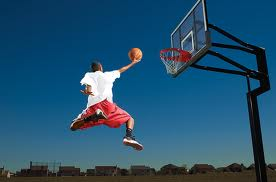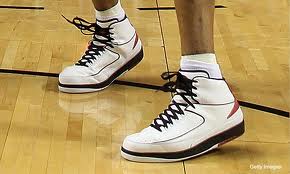 Are you a member of a recreational basketball league? Or, perhaps you like to play in quick pick-up games? Basketball can be an exciting game to play, but it also exerts a tremendous amount of pressure on your feet, ankles and knees. If you don’t wear the right type of shoes, or stretch properly prior to playing, injuries can occur. So, it’s important that you take preventative action to help keep you in the game.
Are you a member of a recreational basketball league? Or, perhaps you like to play in quick pick-up games? Basketball can be an exciting game to play, but it also exerts a tremendous amount of pressure on your feet, ankles and knees. If you don’t wear the right type of shoes, or stretch properly prior to playing, injuries can occur. So, it’s important that you take preventative action to help keep you in the game.
Common Basketball-related Injuries
In basketball, there are two types of injuries:
Acute – These injuries are due to sudden, forceful jolts to the feet, ankles or knees caused by landing incorrectly from a jump or twisting while falling. Some acute injuries that can occur from playing basketball include sprains, torn ligaments, muscle pulls, tendon ruptures and fractures.
Chronic injury – These injuries are due to overuse and develop slowly over time. They are caused by inadequately warming up prior to play, poor training, improperly fitting or worn-out shoes, or a biomechanical condition like overpronation. Plantar fasciitis, shin splints, Achilles tendinitis, patellar tendinitis, and stress fractures are some chronic injuries that often occur from playing basketball.
Injury Prevention
Some ways you can prevent injuries from occurring:
- Be aware that different basketball court surfaces, such as asphalt and concrete, can increase your risk of injuries. Indoor wood courts are safer, providing more shock absorption for your feet, ankles and knees.
- Do stretching exercises, as well as gradually warm up, before every practice and game.
- Perform upper and lower body weight-lifting exercises to reduce your risk of chronic injuries before they occur.
 Wear shoes specifically made for basketball, which provide ankle support and shock absorption. Make sure your shoes fit well and are comfortable. If you’re not sure how to properly fit your shoes, read our Shoe Fitting Guide. Replace your shoes before they show signs of wear, such as the soles becoming smooth, or the uppers tearing or coming apart.
Wear shoes specifically made for basketball, which provide ankle support and shock absorption. Make sure your shoes fit well and are comfortable. If you’re not sure how to properly fit your shoes, read our Shoe Fitting Guide. Replace your shoes before they show signs of wear, such as the soles becoming smooth, or the uppers tearing or coming apart.- Wear acrylic socks to prevent blisters.
- Wear custom orthotic devices, like the ezWalker® Performance Insole, to correct biomechanical imbalances and provide you with the greatest support and shock absorbency possible. During practices and games, your feet and ankles endure abnormal weight and pressure due to sudden stops and quick changes in direction. ezWalker® insoles redistribute your body’s weight evenly over your feet and ankles, reducing pain and helping to prevent injuries.
If an Injury Does Occur
If you injure yourself during the game, you should stop playing and get immediate medical care. Usually initial treatment for an acute injury is ice, rest, compression and elevation of the injured foot or leg.
If you suffer from a chronic injury, you should reduce your intensity of play depending upon how severe your pain is. Be advised that playing on an injured foot or ankle can worsen the condition, leading to a delay in the healing process. If your pain gets worse while playing, you should stop, apply ice to the injured site, apply a compression bandage, and elevate your injured foot or leg. Over-the-counter anti-inflammatory medications, like ibuprofen, can provide temporary pain relief.
If your pain persists, you should see your doctor for proper diagnosis and treatment.
By following these tips and understanding the competitive nature of basketball, you can stay on the court and guard yourself against injury.
The ezWalker® by WalkEz is a slam dunk in foot pain relief. The ezWalker® is ultra thin and ¾ in length, so it easily transfers from your everyday shoes to your basketball shoes– saving you time and money. So you’ll have custom comfort on and off the court. Order your ezWalker® insoles today.
Remember … when your feet feel good, you feel good.


I have Morton’s foot too, but my toes seem to take turns. The most frequent seems to be the 4th toe on the R. Maybe it is that treoucling I only get it on long hilly runs.In addition to bigger shoes, I find that using the heel cinching technique found on various websites inc this to lock the heel down helps hugely (stops foot fr sliding fwd on downhill), as does double-bandaiding the gimpy toe. the fabric ones work best for me.When I bother to wander into Urgent Care and have them pop the subungal hematoma (official sounding huh?) it does save the nail but it’s gotta be fresh, and it’s gotta be bloody/black, and having a hot needle pierce the toenail (and I know it’s not supposed to hurt if done right but uh, yeah, they hit the nailbed, and that was a howl) i’ve chosen to just tough it out and kiss the nail goodbye. I don’t know if it’s the normal thing, but for me, the black toenail stops growing, but a new nail then grows in *under* the dead nail, then the dead guy eventually falls off. Charming eh?
Buy bigger shoes dude. Your toes shouldn’t be getting beat up like that. DUH!